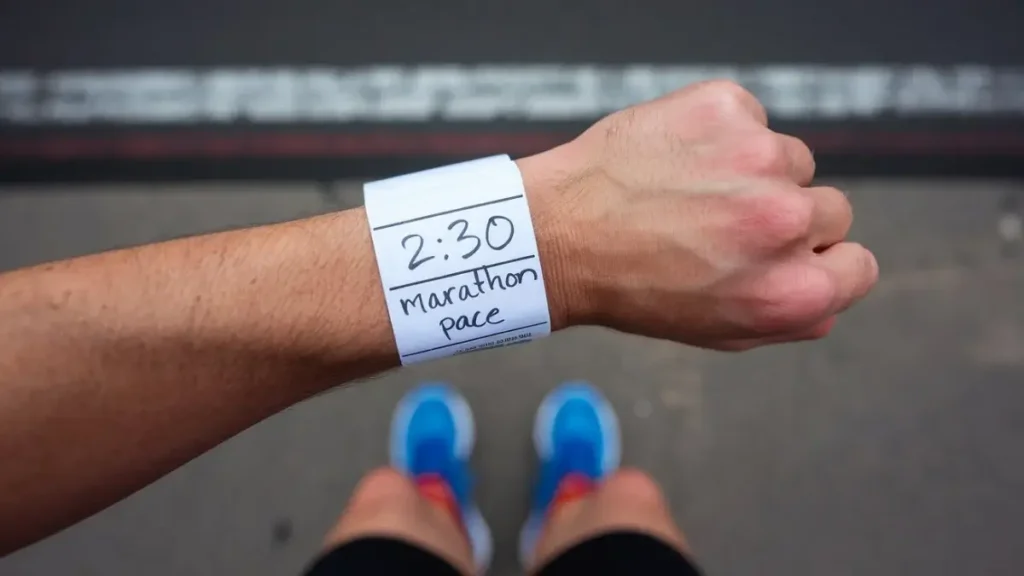To run a 4:05 hour marathon you need to run at a pace of 9:21 per mile or 5:48 per kilometer.
Following the splits below (and shaving off a second), you’ll run a sub 4:05 marathon.
I’d recommend aiming to run 1-2 minutes ahead of the split target time from 10 miles, as you’ll likely come up against crowding on race day.
4:05 Marathon Pace in Miles
| Mile | Split |
|---|---|
| 1 | 9:21 |
| 2 | 18:41 |
| 3 | 28:02 |
| 4 | 37:23 |
| 5 | 46:43 |
| 6 | 56:04 |
| 7 | 1:05:25 |
| 8 | 1:14:45 |
| 9 | 1:24:06 |
| 10 | 1:33:27 |
| 11 | 1:42:47 |
| 12 | 1:52:08 |
| 13 | 2:01:29 |
| 14 | 2:10:49 |
| 15 | 2:20:10 |
| 16 | 2:29:31 |
| 17 | 2:38:51 |
| 18 | 2:48:12 |
| 19 | 2:57:33 |
| 20 | 3:06:53 |
| 21 | 3:16:14 |
| 22 | 3:25:35 |
| 23 | 3:34:55 |
| 24 | 3:44:16 |
| 25 | 3:53:37 |
| 26 | 4:02:57 |
| 26.2 | 4:05:00 |
Download
4:05 Marathon Pace in KM
| KM | Split |
|---|---|
| 1 | 5:48 |
| 2 | 11:37 |
| 3 | 17:25 |
| 4 | 23:14 |
| 5 | 29:02 |
| 6 | 34:50 |
| 7 | 40:39 |
| 8 | 46:27 |
| 9 | 52:15 |
| 10 | 58:04 |
| 11 | 1:03:52 |
| 12 | 1:09:41 |
| 13 | 1:15:29 |
| 14 | 1:21:17 |
| 15 | 1:27:06 |
| 16 | 1:32:54 |
| 17 | 1:38:43 |
| 18 | 1:44:31 |
| 19 | 1:50:19 |
| 20 | 1:56:08 |
| 21 | 2:01:56 |
| 22 | 2:07:44 |
| 23 | 2:13:33 |
| 24 | 2:19:21 |
| 25 | 2:25:10 |
| 26 | 2:30:58 |
| 27 | 2:36:46 |
| 28 | 2:42:35 |
| 29 | 2:48:23 |
| 30 | 2:54:11 |
| 31 | 3:00:00 |
| 32 | 3:05:48 |
| 33 | 3:11:37 |
| 34 | 3:17:25 |
| 35 | 3:23:13 |
| 36 | 3:29:02 |
| 37 | 3:34:50 |
| 38 | 3:40:39 |
| 39 | 3:46:27 |
| 40 | 3:52:15 |
| 41 | 3:58:04 |
| 42 | 4:03:52 |
| 42.2 | 4:05:00 |
Download
Other Marathon Pace Charts
Targeting a different time?
Check out the Full Marathon Pace Chart in Miles or KM
Or select a specific finishing time below:
| 3:00 | 4:00 | 5:00 | |
| 3:05 | 4:05 | 5:15 | |
| 3:10 | 4:10 | 5:30 | |
| 3:15 | 4:15 | 5:45 | |
| 3:20 | 4:20 | 6:00 | |
| 3:25 | 4:25 | 6:15 | |
| 2:30 | 3:30 | 4:30 | 6:30 |
| 2:35 | 3:35 | 4:35 | 6:45 |
| 2:40 | 3:40 | 4:40 | 7:00 |
| 2:45 | 3:45 | 4:45 | |
| 2:50 | 3:50 | 4:50 | |
| 2:55 | 3:55 | 4:55 |
Training for a 4:05 Marathon
Is 4:05 a Good Marathon Time?
Well, what do the stats say?
Run Repeat conducted a study that contains 19,614,975 marathon results from more than 32,335 races across the globe, here is how a 4:05 marathon compares against age and gender for the races recorded:
| Overall | You’re faster than 68.4% of all runners. |
| Male | You’re faster than 58.9% of males. |
| Female | You’re faster than 81.2% of females. |
| <20 | You’re faster than 65.8% of under 20s. |
| 20-29 | You’re faster than 62.5% of 20-29 year olds. |
| 30-39 | You’re faster than 62.3% of 30-39 year olds. |
| 40-49 | You’re faster than 66.5% of 40-49 year olds. |
| 50-59 | You’re faster than 77.3% of 50-59 year olds. |
| >60 | You’re faster than 90.2% of over 60s. |
Training Runs and Paces for a 4:05 Marathon
To break a 4:05 marathon you’ll need to do some serious distance in your training, I recommend at least 15 miles (23km) per week.
You’re also going to need to make sure you’ve crossed off these milestones for other race distances:
- A 5k in 25:30 mins
- A 10k in 53:10 mins
- A half marathon in 1 hour 54 mins
Training Paces
| Pace | Mins per Mile | Mins per KM |
|---|---|---|
| Easy | 10:32 | 6:32 |
| Steady | 9:21 | 5:48 |
| 10k | 8:34 | 5:19 |
| 5k | 8:13 | 5:06 |
| 1 Mile | 7:38 | 4:46 |
Weekly Mileage Targets
| Target Mileage: | Gradually increase your weekly mileage from 25 miles (40 km) to a peak of 42 miles (68 km). |
| Incremental Increase: | Increase mileage by approximately 10% each week, with every fourth week as a recovery week where mileage is reduced by 20-30%. Make sure to taper for the last 1-2 weeks. |
Long Run Structure
| Total Distance: | Build up to long runs of 20-22 miles (32-35 km). |
| Segment Example: | First 5 miles (8 km): Easy pace, heart rate 140-150 bpm (approximately 11:00/mile or 6:50/km). Next 1 mile (1.6 km): Fast pace at 8:00/mile (4:58/km). Next 5 miles (8 km): Medium effort, heart rate around 160 bpm (approximately 9:00/mile or 5:35/km). Repeat: Repeat the segment twice (5 miles easy, 1 mile fast, 5 miles medium), you can taper the final 2 miles if required. |
Why This Works: Incorporating varied paces within long runs enhances lactate tolerance, which helps on race day when you’ve got to maintain pace despite feeling fatigued. By practicing surges during a run, you can build up your physical and mental resilience (lots of elite marathon runners use these strategies during their training)
Alternating Long Runs: Alternate between structured long runs (easy/fast segments) and easier long runs. For easier long runs, maintain a steady, comfortable pace throughout, focusing on mileage rather than speed to aid recovery.
Speedwork Sessions
| Short Intervals: | – 800m repeats at 3:50 per interval (4:48/km). – Aim for 6-12 repetitions with equal time for recovery. |
| Mile Repeats: | – 1 mile repeats at 8:00 per mile (4:58/km). – Aim for 6-12 repetitions with a 1-2 minute recovery jog. |
| Longer Intervals: | – 2 mile repeats at 8:10 per mile (5:04/km). – Aim for 5-8 repetitions with a 2-3 minute recovery jog. |
Recovery and Rest Days
| Rest Days: | You don’t need to incorporate rest days if you are using recovery runs, but I recommend taking 1 (or a max of 2) per week to allow your body to recover and prevent overtraining. |
| Easy Run Days: | Include 1-2 easy run days per week at a relaxed pace of 11:15/mile (7:00/km), covering 5-10 miles (8-16 km) per day. Try to keep your heart rate below 140 bpm on easy days to ensure proper recovery and aerobic development. |
My Tips to Run a Sub 4:05 Marathon
Focus on Mid-Race Mental Toughness
The middle miles of a marathon, especially around miles 13-20, can be mentally tough.
To best way to prepare is to practice some mental strategies during your training runs.
I like to do this by breaking the race down into smaller, more manageable segments.
E.g. you can think of the marathon as two 10-mile runs followed by a 10K.
This mental trick can make the distance feel less overwhelming, as you tunnel vision on a smaller job, and then when that’s complete, you get started on the next.
The other strategy I find useful to stay motivated is positive self-talk/affirmations (my partner swears by these).
Sometimes you just need to tell yourself “I can do this”.
Look back at all the training you’ve (hopefully) completed, and use that as a CV to prove to yourself you’ve got it in you.
Customize Your Hydration Plan
Hydration can make or break your marathon performance, and it’s something that you’ll want to dial in over time.
During your training, experiment with how much and how often you need to drink, depending on factors like weather, sweat rate, and fullness (not feeling bloated).
You’re going to need to either carry a bottle, wear a hydration pack (my personal preference), or plan your routes around water sources to practice drinking at regular intervals.
For me, it’s a big glug of water every 20 mins, with a sip of sports drinks every 30 mins (to wash down my gel).
Knowing your body’s hydration needs for the marathon will prevent dehydration/overhydration, helping you maintain your pace and avoid fatigue.
Incorporate Strength Training for Endurance
Building strength, particularly in your core and lower body, can significantly enhance your running economy, which is massively going to help you to hit your 4:05 marathon goal.
(Running economy is how efficiently your body uses energy when you run, think of it as your “miles per gallon” but for running)
I recommend you add two sessions of strength training per week, focusing on exercises like lunges, squats, and planks.
Stronger muscles can help to improve your form as well as help you to maintain pace over the full marathon distance.
This doesn’t mean you need to be in the gym every day at 6am and become a gym rat.
Even a little commitment to strength training can make those last few miles feel less strenuous.
Adjust Your Training to Your Lifestyle
One thing that can make or break your marathon experience is how well your training plan fits into your lifestyle.
When I’m training for my own marathons, I find that being flexible with my schedule makes all the difference.
If you have a busy week, don’t stress if you need to shuffle your workouts – consistency over time is what really counts.
Consistency > Perfection
Listen to your body and adjust your plan as needed.
This might mean shortening a run, combining workouts, or even taking an extra rest day.
The key is to maintain a balance that allows you to stay committed without burning out or getting injured.
Remember, your marathon training should enhance your life, not take it over.


Row Brown is the founder of Refresh Row. He is a keen marathon runner, his favorite being the London Marathon. He’s now set himself the mission of Running the Entire Length of Spain, which is scheduled for late 2024.


